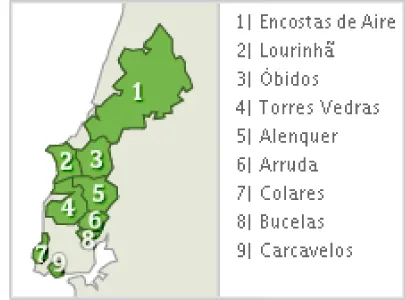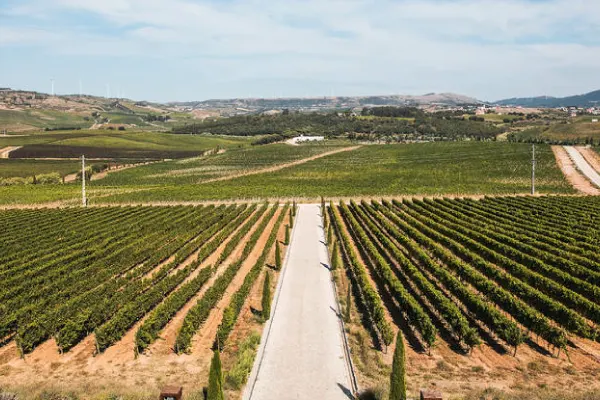The wine region of Lisbon was, until 2008, called Estremadura.
The wines made here largely belong to cooperatives, with a wide variety of styles.
The Lisbon region has conditions to produce quality wines, however, about fifteen years ago, the Lisbon region was essentially known for producing wine in high quantities and quality was not a high priority.
The Vinho Regional de Lisboa area has more DOCs than any other area in Portugal: a total of nine, of which one, Lourinhã, is specific to brandy, rather than wine.

Image: Infovini
Sub-Regions of the Lisbon Wine Region
The Lisbon region is made up of nine Denominations of Origin: Colares, Carcavelos, Bucelas, Alenquer, Arruda, Torres Vedras, Lourinhã, Óbidos and Encostas d'Aire.
The sub-regions of Colares, Carcavelos and Bucelas have almost only a historical interest, the need to urbanize land almost led to the extinction of vines in these sub-regions. Óbidos, Arruda, Torres Vedras and Alenquer received most of the investments: the vineyards were modernized and new varieties were planted.
Colares: it is very close to the sea and its vines are planted on limestone soils or on sand. The wines are essentially made from the Ramisco variety.
Carcavelos: once very important, today it is practically of historical interest only. Long known for its sweet fortified wines. It is in this sub-region that the famous fortified wine Carcavelos is produced, which is at risk of extinction.
Bucelas: the sub-region of Bucelas produces only white wines and was demarcated in 1911. Generally, its wines are made from the Arinto variety, having a balanced acidity, floral aromas and are able to preserve their characteristics for years.
Alenquer: produces one of the most prestigious wines in the Lisbon region. The vineyards are protected from the Atlantic winds, favoring the maturation of the grapes and the production of more concentrated wines.
Lourinhã: is the geographical area corresponding to the production of brandy. The red variety planted in this area is Cabinda and the white varieties are: Alicante Branco, Alvadurão, Boal Espinho, Marquinhas, Malvasia Rei and Tália.
Óbidos, Arruda and Torres Vedras: received the majority of investments in the Lisbon region. Nowadays, the best DOC wines from these areas come from red varieties such as Castelão, Aragonez, Touriga Nacional, Tinta Miúda and Trincadeira, while the white wines come from Arinto, Fernão Pires, Seara-Nova and Vital varieties.
Encostas d’Aire: is the largest sub-region of Lisbon, it was the last to suffer the consequences of modernization. Betting on the planting of new varieties such as Baga or Castelão, and white varieties such as Arinto, Malvasia and Fernão Pires.
Types of wine and grape varieties from the Lisbon Wine Region
Wines from the Lisbon Region usually have little sugar, so the alcohol content varies from low to medium. They have high natural acidity and high freshness, which ends up making them more appealing and pleasant.
The most used red varieties are: Alicante Bouschet, Castelão, Tinta Miúda, Touriga Franca, Touriga Nacional and Trincadeira. And the most common white varieties are: Arinto, Fernão Pires, Malvasia, Seara-Nova and Vital.
Terroir of the Lisbon Wine Region
The Lisbon Region is characterized by having moderate temperatures, fresh and wet winds and high rainfall. Soils are sandy and fertile. The vines established along the coastline suffer from a strong and decisive Atlantic influence, while the vines planted inland, protected from the maritime influence by the various mountain systems, benefit from a transitional Mediterranean climate.

Image: Time Out
Pairing Lisbon wines with food
Wines from the sub-region of Bucelas or Óbidos are great to combine with dishes rich in acidity, such as dishes made up of sauces, vinegar, lemon, capers or tomato.
Wines produced from the Fernão Pires variety combine very well with seafood and Asian spices, such as Indian or Thai food.
 Portugal
Portugal Spain
Spain France
France Germany
Germany United Kingdom
United Kingdom Monaco
Monaco



